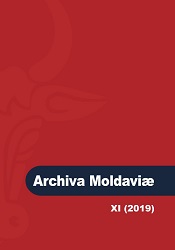România la centenar: o perspectivă critică
Romania at its Centennial Anniversary: A Critical Perspective
Author(s): Dorin DobrincuSubject(s): History, Ethnohistory, History of ideas
Published by: Societatea de Studii Istorice din România
Keywords: Oliver Jens Schmitt; Romania from 1918 to 2018; Orthodox ethno- nationalism; authoritarianism; Romanian secret services; Romanian Army; Romanian Orthodox Church; Romanian Academy;
Summary/Abstract: This text discusses the latest book published by Oliver Jens Schmitt – România în 100 de ani: bilanțul unui veac de istorie. This volume proposes a critical review and analysis of the time period ranging from the crystallization of the political entity which became known, after World War I, as Greater Romania, to the recent official celebra-tions of this historical occurrence. In his analysis, the author follows an approach informed by democratic and liberal values. This perspective obviously goes against the grain of the nationalist tendency exhibited by many local historians. In his work, Schmitt strove to analyze and examine the defining features of Romanian statehood and nation-building during the last century, emphasizing in particular the state-society interactions. The author identifies three main periods in the history of contemporary Romania, i.e., the interwar years, the Communist period, and the post-1989 era. His periodization is mainly constructed on the basis of political and ideological criteria. Schmitt focuses his attention on the crucial moments of historical ruptures and discontinuities from the last century: the creation of Greater Romania in 1918; the establishment of King Carol II’s royal dictatorship in 1938; the major territorial losses of 1940 and the emergence of General Ion Antonescu’s dictatorial regime; the trajectory leading to the gradual seizure of power by the Communist Party, following the events of 23 August 1944; the transition towards a democratic political system, inaugurated in December 1989. The Romanian political system, its nature, its essential features, its supporters and its fundamental dynamics are of central signi-ficance to Schmitt’s analytical framework. The author’s conclusion is clear: authorita-rianism, in various guises, represented the dominant political regime in Romania until 1989. In this sense, Schmitt explicitly refers to the dictatorships successively established by King Carol II, the Iron Guard, the military led by Antonescu, and the Communists. According to Schmitt’s interpretation, from an ideological point of view, the main defining feature of the authoritarian state in Romania during the past century was Orthodox ethno-nationalism. The nationalist discourse glorified the authoritarian state, which was ultimately based on several key institutions subordinated to it or closely identified with its purposes, to the point of almost totally merging with the state apparatus, e.g., the secret services, the Army, the Romanian Orthodox Church, and the Romanian Academy. Orthodox ethno-nationalism thrived and reproduced itself, through these institutions, throughout the past century. Regardless and beyond all the political changes, theabove-mentioned institutions survived, while the continuities in their evolution proved to be more important than the ruptures. Present-day Romania is passing through a favorable moment of its history. After becoming a member of prominent international “clubs” based on shared interests and values (NATO and the European Union), the country witnessed an important and growing societal support for the democratic system, rather than for various forms of nationalism and authoritarianism. There is a solid and strong civil society, coupled with extended and widespread personal connections, while the new media outlets offer unprecedented opportunities for acquiring information and for the critical assessment of and attitude towards the current political, economic, and cultural realities. Romania’s present is hopeful and, in comparison, surely better than everything that had defined its development during the previous century, both internally and externally.
Journal: Archiva Moldaviae
- Issue Year: XI/2019
- Issue No: 11
- Page Range: 465-475
- Page Count: 11
- Language: Romanian

